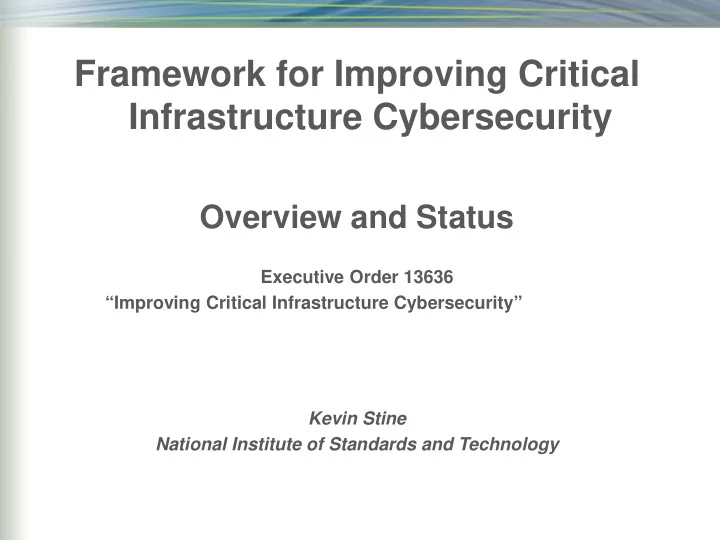

Framework for Improving Critical Infrastructure Cybersecurity Overview and Status Executive Order 13636 “Improving Critical Infrastructure Cybersecurity” Kevin Stine National Institute of Standards and Technology
Executive Order 13636: Improving Critical Infrastructure Cybersecurity “It is the policy of the United States to enhance the security and resilience of the Nation’s critical infrastructure and to maintain a cyber environment that encourages efficiency, innovation, and economic prosperity while promoting safety, security, business confidentiality, privacy, and civil liberties” President Barack Obama Executive Order 13636, Feb. 12, 2013 • The National Institute of Standards and Technology (NIST) was directed to work with stakeholders to develop a voluntary framework for reducing cyber risks to critical infrastructure • Version 1.0 of the framework was released on Feb. 12, 2014, along with a roadmap for future work 2
The Cybersecurity Framework... • Includes a set of standards, methodologies, procedures, and processes that align policy, business, and technological approaches to address cyber risks • Provides a prioritized, flexible, repeatable, performance-based, and cost-effective approach, including information security measures and controls, to help owners and operators of critical infrastructure identify, assess, and manage cyber risk • Identifies areas for improvement to be addressed through future collaboration with particular sectors and standards-developing organizations 3
The Cybersecurity Framework… • Provides a structure organizations can use to create, guide, assess or improve comprehensive cybersecurity programs based on risks • Offers a common language to address and manage cyber risk in a cost-effective way based on business needs, without placing additional regulatory requirements on businesses • Allows organizations—regardless of size, degree of cyber risk or cybersecurity sophistication—to apply the principles and best practices of risk management to improve the security and resilience of critical infrastructure • Helps companies prove to themselves and their stakeholders that good cybersecurity is good business • Builds on global and other standards, guidelines, and best practices • Provides a means of expressing cybersecurity requirements to business partners and customers • Assists organizations in incorporating privacy and civil liberties as part of a comprehensive cybersecurity program 4
Framework Components Framework Core • Cybersecurity activities and informative references common across critical infrastructure sectors and organized around particular outcomes • Enables communication of cyber risk across an organization Framework Profile • Aligns industry standards and best practices to the framework Core in a particular implementation scenario • Supports prioritization and measurement of progress toward the Target Profile, while factoring in other business needs— including cost-effectiveness and innovation Framework Implementation Tiers • Describes how cybersecurity risk is managed by an organization • Describes degree to which an organization’s cybersecurity risk management practices exhibit the key characteristics (e.g., risk and threat aware, repeatable, and adaptive) 5
Framework Core 6
What’s Next: Using the Cybersecurity Framework • Organizations—led by their senior executives—should use the framework now, and provide feedback to NIST • Industry groups, associations, and non-profits can play key roles in assisting their members to understand and use the framework by: • Building or mapping their sector’s specific standards, guidelines, and best practices to the framework • Developing and sharing examples of how organizations are using the framework • NIST is committed to helping organizations understand and use the framework • NIST is expanding its outreach and will work with the Department of Homeland Security on its “C 3 ” Voluntary Program (http://www.dhs.gov/about-critical-infrastructure-cyber- community-c³-voluntary-program) 7
What’s Next: Areas for Development, Alignment, and Collaboration • The Executive Order calls for the framework to “identify areas for improvement that should be addressed through future collaboration with particular sectors and standards-developing organizations” • High-priority areas for development, alignment, and collaboration were identified based on stakeholder input: • Authentication • Automated Indicator Sharing • Conformity Assessment • Cybersecurity Workforce • Data Analytics • Federal Agency Cybersecurity Alignment • International Aspects, Impacts, and Alignment • Supply Chain Risk Management • Technical Privacy Standards 8
Cybersecurity Workforce: Training and Preparing • A skilled cybersecurity workforce is needed to meet the unique cybersecurity needs of critical infrastructure. • Adapt to continuously improve the necessary cybersecurity practices. • Organizations must understand their current and future cybersecurity workforce needs. • Develop training awareness, training, and education resources to raise the level of technical competence. • Promote existing and future cybersecurity workforce development activities to expand and fill the cybersecurity workforce pipeline. 9
What’s Next: Roadmap for the Framework • NIST will work with stakeholders to further understand these areas for development, alignment and collaboration and to develop or identify new or revised standards • For specifics, see the companion Roadmap to the framework that also was issued Feb. 12, 2014 : http://nist.gov/cyberframework/upload/roadmap-021214.pdf • Areas for development, alignment, and collaboration are covered in greater detail • Strengthening private sector involvement in long-term governance of the framework is also discussed 10
Where to Learn More and Stay Current The Framework for Improving Critical Infrastructure Cybersecurity , the Roadmap , and related news and information are available at: http://www.nist.gov/cyberframework 11
Recommend
More recommend